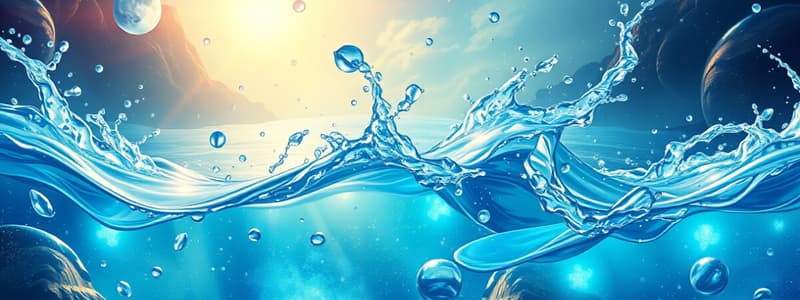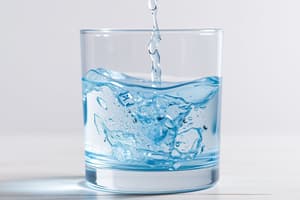Podcast
Questions and Answers
Which of the following best describes the properties of water that make it essential for life?
Which of the following best describes the properties of water that make it essential for life?
- It is a poor solvent for polar molecules.
- It exhibits high cohesion and adhesion qualities. (correct)
- It has a low boiling point, which allows for rapid evaporation.
- It is non-polar, enabling it to interact uniformly with all substances.
What type of bond is primarily responsible for the unique properties of water?
What type of bond is primarily responsible for the unique properties of water?
- Ionic bonds that form between water and other molecules.
- Covalent bonds between water molecules.
- Hydrogen bonds that create temporary attractions. (correct)
- Van der Waals forces that hold surface tension.
Which characteristic of water contributes to its high specific heat?
Which characteristic of water contributes to its high specific heat?
- The strong ionic bonds in its molecular structure.
- The hydrogen bonds that must be broken for temperature changes. (correct)
- The large size of the water molecules.
- The presence of carbon atoms in water molecules.
What is the primary reason water acts as an excellent solvent for biochemical reactions?
What is the primary reason water acts as an excellent solvent for biochemical reactions?
What is the role of hydrophobic interactions in aqueous systems?
What is the role of hydrophobic interactions in aqueous systems?
Which property of water helps in regulating temperature within an organism?
Which property of water helps in regulating temperature within an organism?
What distinguishes hydrophilic substances from hydrophobic substances in water interactions?
What distinguishes hydrophilic substances from hydrophobic substances in water interactions?
Which pair of substances can form hydrogen bonds with water?
Which pair of substances can form hydrogen bonds with water?
What role do ionic bonds play in the chemical properties of water?
What role do ionic bonds play in the chemical properties of water?
What is the pH range that indicates a solution is acidic?
What is the pH range that indicates a solution is acidic?
Which of the following correctly represents an ionization equation for a strong acid?
Which of the following correctly represents an ionization equation for a strong acid?
Which of the following is a characteristic of weak acids?
Which of the following is a characteristic of weak acids?
Identify the common weak base from these options.
Identify the common weak base from these options.
What characterizes a strong base in solution?
What characterizes a strong base in solution?
Which of the following pairs corresponds to a strong acid and a weak base?
Which of the following pairs corresponds to a strong acid and a weak base?
What does the notation [H+] > [OH-] imply about a solution?
What does the notation [H+] > [OH-] imply about a solution?
Which formula represents a weak acid?
Which formula represents a weak acid?
What characterizes a buffer solution?
What characterizes a buffer solution?
Which species is the conjugate acid of a weak base like ammonia?
Which species is the conjugate acid of a weak base like ammonia?
How does a buffer react when a strong acid is added?
How does a buffer react when a strong acid is added?
What is the physiological pH maintained by a phosphate buffer?
What is the physiological pH maintained by a phosphate buffer?
Which of the following is an example of a weak acid and its conjugate base used in buffers?
Which of the following is an example of a weak acid and its conjugate base used in buffers?
Which of the following statements about conjugate bases is true?
Which of the following statements about conjugate bases is true?
Which of the following correctly describes how buffers function?
Which of the following correctly describes how buffers function?
What does a buffer consist of?
What does a buffer consist of?
What is the pH of a neutral solution at 25 °C?
What is the pH of a neutral solution at 25 °C?
Which equation correctly represents the equilibrium constant for the autoionization of water?
Which equation correctly represents the equilibrium constant for the autoionization of water?
In a basic solution, which condition is true regarding H+ and OH- concentrations?
In a basic solution, which condition is true regarding H+ and OH- concentrations?
How is pH defined in terms of hydrogen ion concentration?
How is pH defined in terms of hydrogen ion concentration?
What happens to the concentrations of H+ and OH- in pure water at 25 °C?
What happens to the concentrations of H+ and OH- in pure water at 25 °C?
What is the primary role of bicarbonate in the blood buffer system?
What is the primary role of bicarbonate in the blood buffer system?
How does respiratory acidosis differ from metabolic acidosis?
How does respiratory acidosis differ from metabolic acidosis?
What could potentially indicate a state of alkalosis in an individual?
What could potentially indicate a state of alkalosis in an individual?
In the Henderson-Hasselbalch equation for weak acids, what happens when the concentrations of the acid and its conjugate base are equal?
In the Henderson-Hasselbalch equation for weak acids, what happens when the concentrations of the acid and its conjugate base are equal?
Which symptom is commonly associated with respiratory alkalosis?
Which symptom is commonly associated with respiratory alkalosis?
What is the effect of administering bicarbonate to a patient experiencing acidosis?
What is the effect of administering bicarbonate to a patient experiencing acidosis?
What equilibrium process occurs when an acidic substance enters the blood?
What equilibrium process occurs when an acidic substance enters the blood?
What is the relationship between pH and pOH in a solution?
What is the relationship between pH and pOH in a solution?
What physiological condition can lead to respiratory acidosis?
What physiological condition can lead to respiratory acidosis?
What is a common treatment approach for metabolic alkalosis?
What is a common treatment approach for metabolic alkalosis?
Flashcards are hidden until you start studying
Study Notes
Properties of Water
- Water's chemical formula is H2O, comprising one oxygen atom and two hydrogen atoms.
- Water is a polar molecule, leading to unique interactions and bond formations.
- Cohesion refers to water molecules sticking together, while adhesion involves water molecules attaching to other substances.
- Water has a high boiling point (100°C) and high specific heat, crucial for temperature regulation and maintaining homeostasis.
- Acts as an excellent solvent for polar molecules, enabling vital chemical reactions in living organisms.
Ionization of Water, Acids, and Bases
- Water can behave as both an acid and a base due to its polar structure.
- Autoionization of water occurs, producing hydrogen ions (H+) and hydroxide ions (OH-).
- At 25°C, the equilibrium constant (Kw) is 1.0×10−14, with equal concentrations of H+ and OH- in pure water at 1.0×10−7 M.
- pH measures hydrogen ion concentration, with pure water having a neutral pH of 7.
Strong and Weak Acids/Bases
- Strong Acids: Nearly 100% ionized in solution; examples include hydrochloric acid (HCl) and sulfuric acid (H2SO4).
- Weak Acids: Partially dissociate in solution; examples include acetic acid (CH3COOH) and hydrofluoric acid (HF).
- Strong Bases: Fully ionized in solution; examples include sodium hydroxide (NaOH) and potassium hydroxide (KOH).
- Weak Bases: Partially dissociate; examples include ammonia (NH3) and pyridine (C5H5N).
Buffer Systems
- Buffers resist pH changes when acids or bases are added, consisting of weak acids and their conjugate bases or vice versa.
- The phosphate buffer helps maintain blood pH at approximately 7.4.
- Buffers work by neutralizing excess H+ with a base or excess OH- with an acid.
Henderson-Hasselbalch Equation
- For a weak acid-HA and conjugate base-A−, if [A-] = [HA], then pH = pKa.
- The relationship between pH and pOH is pH + pOH = 14.
Blood Buffer System
- Blood utilizes carbonic acid (H2CO3) and bicarbonate ion (HCO3−) to maintain pH levels between 7.35 and 7.45.
- Excess acidic or basic substances in blood trigger reactions that either produce carbonic acid or bicarbonate, adjusting pH accordingly.
Acid-Base Balance Disorders
- Acidosis: Blood pH falls below 7.35, classified into respiratory (due to CO2 accumulation) and metabolic (due to excess acids or loss of bicarbonate).
- Alkalosis: Blood pH rises above 7.45, also classified into respiratory (CO2 loss) and metabolic (excess bicarbonate or depletion of acids).
Diagnosis and Treatment of Disorders
- Diagnosis of acid-base balance issues involves measuring arterial blood gases (ABGs) for pH and constituent levels.
- Treatment options include administering bicarbonate for acidosis or acidifying agents for alkalosis and adjusting ventilation for respiratory disorders.
Studying That Suits You
Use AI to generate personalized quizzes and flashcards to suit your learning preferences.



